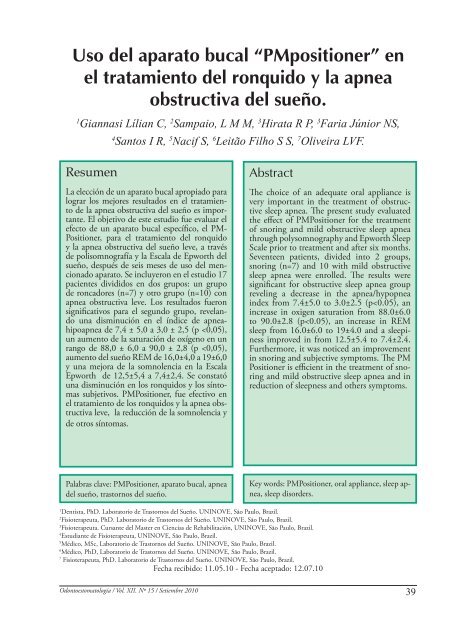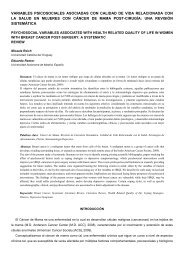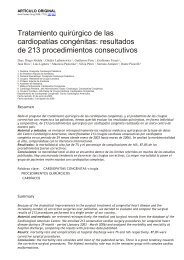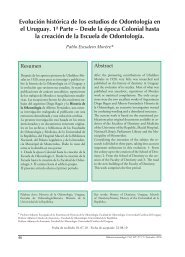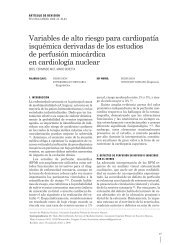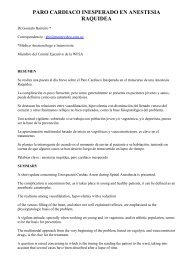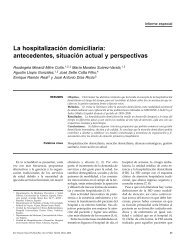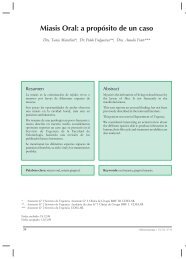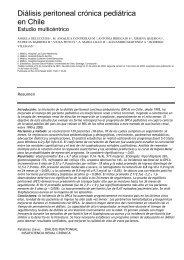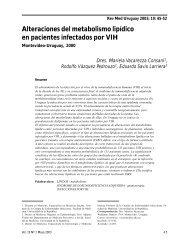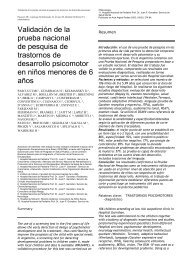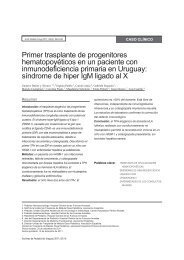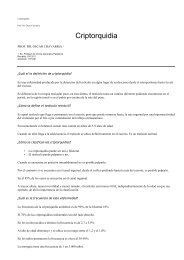en el tratamiento del ronquido y la apnea obstructiva del ... - SciELO
en el tratamiento del ronquido y la apnea obstructiva del ... - SciELO
en el tratamiento del ronquido y la apnea obstructiva del ... - SciELO
Create successful ePaper yourself
Turn your PDF publications into a flip-book with our unique Google optimized e-Paper software.
Uso d<strong>el</strong> aparato bucal “PMpositioner” <strong>en</strong><br />
<strong>el</strong> tratami<strong>en</strong>to d<strong>el</strong> <strong>ronquido</strong> y <strong>la</strong> <strong>apnea</strong><br />
<strong>obstructiva</strong> d<strong>el</strong> sueño.<br />
1<br />
Giannasi Lílian C, 2 Sampaio, L M M, 3 Hirata R P, 3 Faria Júnior NS,<br />
4<br />
Santos I R, 5 Nacif S, 6 Leitão Filho S S, 7 Oliveira LVF.<br />
Resum<strong>en</strong><br />
La <strong>el</strong>ección de un aparato bucal apropiado para<br />
lograr los mejores resultados <strong>en</strong> <strong>el</strong> tratami<strong>en</strong>to<br />
de <strong>la</strong> <strong>apnea</strong> <strong>obstructiva</strong> d<strong>el</strong> sueño es importante.<br />
El objetivo de este estudio fue evaluar <strong>el</strong><br />
efecto de un aparato bucal específico, <strong>el</strong> PM-<br />
Positioner, para <strong>el</strong> tratami<strong>en</strong>to d<strong>el</strong> <strong>ronquido</strong><br />
y <strong>la</strong> <strong>apnea</strong> <strong>obstructiva</strong> d<strong>el</strong> sueño leve, a través<br />
de polisomnografía y <strong>la</strong> Esca<strong>la</strong> de Epworth d<strong>el</strong><br />
sueño, después de seis meses de uso d<strong>el</strong> m<strong>en</strong>cionado<br />
aparato. Se incluyeron <strong>en</strong> <strong>el</strong> estudio 17<br />
paci<strong>en</strong>tes divididos <strong>en</strong> dos grupos: un grupo<br />
de roncadores (n=7) y otro grupo (n=10) con<br />
<strong>apnea</strong> <strong>obstructiva</strong> leve. Los resultados fueron<br />
significativos para <strong>el</strong> segundo grupo, rev<strong>el</strong>ando<br />
una disminución <strong>en</strong> <strong>el</strong> índice de <strong>apnea</strong>hipo<strong>apnea</strong><br />
de 7,4 ± 5,0 a 3,0 ± 2,5 (p
Introducción<br />
La <strong>apnea</strong> <strong>obstructiva</strong> d<strong>el</strong> sueño (AOS) se caracteriza<br />
por una obstrucción total o parcial de <strong>la</strong> vía aérea<br />
superior, por lo m<strong>en</strong>os de 10 segundos con desaturación<br />
de <strong>la</strong> oxihemoglobina y despertares durante<br />
<strong>el</strong> sueño (1). La AOS es una condición compleja y<br />
algunos autores afirman que su fisiopatología puede<br />
estar r<strong>el</strong>acionada a alteraciones neuromuscu<strong>la</strong>res<br />
(2). La obstrucción de <strong>la</strong> faringe también puede<br />
ser inducida por: consumo de alcohol y/o drogas,<br />
hipertrofia de amígda<strong>la</strong>s, macroglosia, anormalidades<br />
cráneofaciales y aum<strong>en</strong>to <strong>en</strong> <strong>el</strong> tejido adiposo o<br />
líquido <strong>en</strong> <strong>la</strong> región d<strong>el</strong> cu<strong>el</strong>lo (3-6).<br />
Los síntomas más frecu<strong>en</strong>tes de <strong>la</strong> AOS son:<br />
<strong>ronquido</strong>s, somnol<strong>en</strong>cia diurna excesiva, fatiga,<br />
depresión, déficit de at<strong>en</strong>ción, dolor de cabeza<br />
matutino y disfunción sexual (7-9). Si esta condición<br />
(AOS) no recibe tratami<strong>en</strong>to, puede dar<br />
lugar a cambios significativos <strong>en</strong> <strong>el</strong> sistema cardiovascu<strong>la</strong>r,<br />
tales como <strong>la</strong> aparición de arritmias<br />
cardíacas, hipert<strong>en</strong>sión e isquemia miocárdica, así<br />
como cambios <strong>en</strong> <strong>el</strong> sistema <strong>en</strong>dócrino y trastornos<br />
cognitivos (10).<br />
La terapia con <strong>la</strong> utilización de un aparato bucal<br />
(AB) es <strong>el</strong> tratami<strong>en</strong>to más frecu<strong>en</strong>te para <strong>la</strong> <strong>apnea</strong><br />
<strong>obstructiva</strong> d<strong>el</strong> sueño (AOS). En <strong>la</strong> última década,<br />
los estudios han demostrado que los aparatos bucales<br />
son eficaces y seguros para los paci<strong>en</strong>tes con<br />
<strong>apnea</strong> <strong>obstructiva</strong> d<strong>el</strong> sueño (11). Investigaciones<br />
sobre los trastornos d<strong>el</strong> sueño y <strong>la</strong> fisiopatología<br />
de <strong>la</strong> AOS destacan <strong>el</strong> importante pap<strong>el</strong> que puede<br />
desempeñar <strong>el</strong> odontólogo para mejorar <strong>la</strong> calidad<br />
de vida de <strong>la</strong>s personas con AOS. La etiología<br />
de esta condición parece ser una combinación de<br />
alteraciones orofaciales y factores neuromuscu<strong>la</strong>res<br />
que conduc<strong>en</strong> a <strong>la</strong> obstrucción de <strong>la</strong>s vías respiratorias<br />
superiores.<br />
Actualm<strong>en</strong>te, <strong>en</strong> <strong>el</strong> mercado exist<strong>en</strong> varios tipos<br />
de aparatos bucales, para <strong>el</strong> tratami<strong>en</strong>to de este<br />
síndrome. En cada caso es muy importante valorar<br />
<strong>el</strong> tipo de dispositivo que ofrezca <strong>la</strong> mayor<br />
eficacia con los m<strong>en</strong>ores efectos secundarios. Los<br />
aparatos bucales se divid<strong>en</strong> habitualm<strong>en</strong>te <strong>en</strong> dos<br />
grandes grupos: A) ret<strong>en</strong>edores de <strong>la</strong> l<strong>en</strong>gua y B)<br />
dispositivos de avance mandibu<strong>la</strong>r. Este último<br />
se subdivide <strong>en</strong> tipo monoblock y tipo ajustable,<br />
que es <strong>el</strong> más utilizado y estudiado <strong>en</strong> <strong>la</strong> literatura<br />
actual (12). Los dispositivos bucales también se<br />
difer<strong>en</strong>cian <strong>en</strong> <strong>el</strong> material de fabricación y <strong>en</strong> <strong>la</strong><br />
posibilidad de ajuste para <strong>el</strong> estímulo d<strong>el</strong> avance<br />
mandibu<strong>la</strong>r <strong>en</strong> forma increm<strong>en</strong>tal, proceso d<strong>en</strong>ominado<br />
como “titration”. Estudios contro<strong>la</strong>dos,<br />
aleatorios y cruzados han demostrado que los dispositivos<br />
confeccionados con resina acrílica son<br />
más eficaces que los realizados con materiales termoplásticos<br />
tipo “hervir y morder”. D<strong>el</strong> mismo<br />
modo, un aparato ajustable es más efectivo que<br />
uno tipo monoblock porque éste no permite <strong>el</strong><br />
ad<strong>el</strong>antami<strong>en</strong>to mandibu<strong>la</strong>r progresivo (13,14).<br />
Estas difer<strong>en</strong>cias son es<strong>en</strong>ciales para <strong>la</strong> eficacia<br />
de un AB <strong>en</strong> <strong>el</strong> tratami<strong>en</strong>to de <strong>la</strong> AOS. Estudios<br />
específicos han demostrado <strong>la</strong> eficacia d<strong>el</strong> uso de<br />
aparatología ajustable <strong>en</strong> <strong>la</strong> disminución d<strong>el</strong> Índice<br />
<strong>apnea</strong> / hipo<strong>apnea</strong> (IAH), <strong>en</strong> <strong>el</strong> aum<strong>en</strong>to de<br />
<strong>la</strong> saturación de oxíg<strong>en</strong>o durante <strong>el</strong> sueño, <strong>en</strong> <strong>la</strong><br />
disminución de <strong>la</strong> presión arterial y <strong>en</strong> <strong>la</strong> mejora<br />
d<strong>el</strong> ritmo cardíaco (15-22). El Índice de <strong>apnea</strong>/<br />
hipo<strong>apnea</strong> <strong>obstructiva</strong> indica <strong>la</strong> cantidad de ev<strong>en</strong>tos<br />
respiratorios por hora que ocurr<strong>en</strong> durante <strong>el</strong><br />
sueño. Según <strong>la</strong> Academia Americana de Medicina<br />
d<strong>el</strong> Sueño, <strong>el</strong> uso de AB repres<strong>en</strong>ta <strong>la</strong> primera<br />
opción de tratami<strong>en</strong>to para los <strong>ronquido</strong>s, <strong>el</strong> síndrome<br />
de resist<strong>en</strong>cia de <strong>la</strong> vía aérea superior (SR-<br />
VAS) y <strong>la</strong> AOS leve y constituye <strong>la</strong> segunda opción<br />
de tratami<strong>en</strong>to para los paci<strong>en</strong>tes con AOS<br />
moderada o severa que se niegan a <strong>la</strong> terapia con<br />
presión positiva continua de <strong>la</strong> vía aérea (23).<br />
El objetivo de este estudio fue evaluar <strong>el</strong> uso de un<br />
aparato bucal ajustable, <strong>el</strong> PMPositioner, para <strong>el</strong><br />
tratami<strong>en</strong>to de <strong>ronquido</strong>s y <strong>la</strong> AOS leve. Se compararon<br />
los datos obt<strong>en</strong>idos por polisomnografía,<br />
antes y después de seis meses de uso d<strong>el</strong> m<strong>en</strong>cionado<br />
dispositivo y se evaluó <strong>la</strong> somnol<strong>en</strong>cia utilizando<br />
<strong>la</strong> Esca<strong>la</strong> de Epworth d<strong>el</strong> Sueño (EES) (24).<br />
La polisonmografía o poligrafía respiratoria (PSG)<br />
es un método de refer<strong>en</strong>cia (gold standard) que se<br />
recomi<strong>en</strong>da para <strong>el</strong> diagnóstico de paci<strong>en</strong>tes con<br />
presunción de AOS. Consiste <strong>en</strong> <strong>el</strong> registro simultáneo<br />
de variables neurofisiológicas y respiratorias<br />
que permit<strong>en</strong> evaluar <strong>la</strong> cantidad y calidad d<strong>el</strong><br />
sueño así como id<strong>en</strong>tificar los difer<strong>en</strong>tes ev<strong>en</strong>tos<br />
respiratorios y su repercusión cardiorespiratoria y<br />
neurofisiológica (25).<br />
40 Giannasi Lílian C - Sampaio, L M M - Hirata R P - Faria Júnior NS - Santos I R - Nacif S - Leitão Filho S S - Oliveira LVF.
Material y métodos<br />
Se incluyeron <strong>en</strong> <strong>el</strong> estudio 17 paci<strong>en</strong>tes con los<br />
sigui<strong>en</strong>tes signos y síntomas: <strong>ronquido</strong>s, respiración<br />
jadeante, somnol<strong>en</strong>cia, fatiga, alteraciones<br />
d<strong>el</strong> sueño y <strong>la</strong>psos de pérdida de memoria. Todos<br />
los paci<strong>en</strong>tes fueron examinados por un médico<br />
especialista <strong>en</strong> trastornos d<strong>el</strong> sueño realizándoles<br />
una polisomnografía d<strong>el</strong> sueño inicial (PSG)<br />
<strong>en</strong> <strong>el</strong> Laboratorio de Trastornos d<strong>el</strong> Sueño <strong>en</strong> <strong>la</strong><br />
Universidad de Nove de Julho (UNINOVE), San<br />
Pablo, Brasil. Previo al tratami<strong>en</strong>to, se realizó una<br />
historia clínica detal<strong>la</strong>da d<strong>el</strong> paci<strong>en</strong>te y <strong>el</strong> exam<strong>en</strong><br />
bucal fue efectuado por un odontólogo especialista<br />
<strong>en</strong> trastornos d<strong>el</strong> sueño. Al mismo tiempo, se<br />
aplicó <strong>el</strong> cuestionario-EES para evaluar <strong>la</strong> somnol<strong>en</strong>cia<br />
diurna excesiva.<br />
Se excluyeron paci<strong>en</strong>tes con: índice de masa corporal<br />
(IMC) superior a 33 Kg/m 2 , dolor <strong>en</strong> <strong>la</strong><br />
articu<strong>la</strong>ción témporomandibu<strong>la</strong>r, <strong>en</strong>fermedad<br />
periodontal activa, obstrucción de vías aéreas y<br />
<strong>apnea</strong> c<strong>en</strong>tral d<strong>el</strong> sueño. Los criterios de inclusión<br />
fueron: salud periodontal, protrusión mandibu<strong>la</strong>r<br />
mayor de 7 mm., apertura bucal superior a 35<br />
mm., pres<strong>en</strong>cia de 8 a 10 di<strong>en</strong>tes <strong>en</strong> cada arcada.<br />
Todos los paci<strong>en</strong>tes firmaron <strong>el</strong> cons<strong>en</strong>timi<strong>en</strong>to<br />
informado y <strong>el</strong> estudio fue aprobado por <strong>el</strong> Comité<br />
de Ética de UNINOVE.<br />
Figura 1: Aparato Bucal<br />
Los dispositivos fueron realizados <strong>en</strong> un <strong>la</strong>boratorio<br />
d<strong>en</strong>tal, sobre mod<strong>el</strong>os de yeso de ambas arcadas<br />
y mordidas <strong>en</strong> cera efectuadas con un máximo de<br />
65% de protrusión mandibu<strong>la</strong>r. El mismo diseño,<br />
PMPositioner ajustable, se utilizó para todos los paci<strong>en</strong>tes<br />
(Figura 1). El aparato consta de dos p<strong>la</strong>cas<br />
(superior e inferior) que cubr<strong>en</strong> completam<strong>en</strong>te <strong>la</strong>s<br />
superficies oclusales de los di<strong>en</strong>tes y se manti<strong>en</strong><strong>en</strong><br />
unidas por tornillos expansores ubicados <strong>la</strong>teralm<strong>en</strong>te,<br />
que facilitan <strong>el</strong> ad<strong>el</strong>antami<strong>en</strong>to mandibu<strong>la</strong>r,<br />
de acuerdo a <strong>la</strong>s necesidades d<strong>el</strong> paci<strong>en</strong>te.<br />
El ajuste para promover <strong>el</strong> ad<strong>el</strong>antami<strong>en</strong>to mandibu<strong>la</strong>r<br />
se realizó <strong>en</strong> forma semanal hasta lograr <strong>la</strong><br />
reducción o <strong>el</strong>iminación de <strong>la</strong> sintomatología. El<br />
avance mandibu<strong>la</strong>r promedio alcanzado fue de 9,5<br />
mm. Los paci<strong>en</strong>tes usaron <strong>el</strong> dispositivo durante<br />
seis meses, seis a siete noches por semana, se realizó<br />
una segunda PSG con <strong>el</strong> aparato <strong>en</strong> boca y respondieron<br />
a un nuevo test-EES. Las variables polisomnográficas<br />
fueron analizadas con <strong>el</strong> test de Stud<strong>en</strong>t<br />
obt<strong>en</strong>iéndose un niv<strong>el</strong> de significación de p
El grupo <strong>ronquido</strong> (GR) no pres<strong>en</strong>tó cambios<br />
significativos <strong>en</strong> <strong>la</strong>s variables estudiadas aunque<br />
según informe de <strong>la</strong>s parejas de los paci<strong>en</strong>tes, <strong>el</strong><br />
<strong>ronquido</strong> desapareció (Tab<strong>la</strong> 1).<br />
Tab<strong>la</strong> 1: Variables fisiológica d<strong>el</strong> sueño GR (n=7) y GAOS (n=10) con y sin AB después de 6 meses.<br />
Valores promedio y desvío estándar<br />
PSG/GAOS n = 10 Sin AB Con AB Test Stud<strong>en</strong>t<br />
IAH 7,4±5.0 3.0±2.5 p< 0.05<br />
SaO 2 min<br />
88.0±6.0 90.0±2.8 p< 0.05<br />
REM 18.0 ± 6.6 19.0 ± 4.0 p< 0.05<br />
EES 12.5±5.4 7.4±2.4 p< 0.05<br />
PSG/GR n = 7 Sin AB Con AB Test Stud<strong>en</strong>t<br />
IAH 3.0 ±0.95 1.1±0.80 No signif.<br />
SaO 2 min<br />
85.0±3.4 86.0±2.4 No signif.<br />
REM 19.0±2.0 19.0±3.0 No signif.<br />
EES 9.0±4.6 7.0±2.0 No signif.<br />
PSG=polisomnografía; AB=aparato bucal; IAH=Índice de <strong>apnea</strong>/hipo<strong>apnea</strong>; SAO 2 min= mínima saturación<br />
de oxíg<strong>en</strong>o; EES=Esca<strong>la</strong> de Epworth d<strong>el</strong> sueño; REM=movimi<strong>en</strong>to rápido de ojos<br />
Discusión<br />
La aparatología bucal se ha convertido <strong>en</strong> una<br />
modalidad de tratami<strong>en</strong>to de rutina para paci<strong>en</strong>tes<br />
de AOS <strong>en</strong> todo <strong>el</strong> mundo. Este estudio<br />
demuestra que <strong>el</strong> tipo de aparato bucal utilizado<br />
durante 6 meses redujo <strong>el</strong> Índice de <strong>apnea</strong>/hipo<strong>apnea</strong><br />
(p
y también observaron una disminución <strong>en</strong> <strong>el</strong> IAH<br />
y un aum<strong>en</strong>to de SaO 2<br />
mínima (27).<br />
Al igual que <strong>en</strong> <strong>el</strong> pres<strong>en</strong>te estudio, Marklund y<br />
Rose (2000) no <strong>en</strong>contraron resultados estadísticam<strong>en</strong>te<br />
significativos <strong>en</strong> <strong>la</strong>s fases de sueño (S)<br />
aplicando este dispositivo (28, 29). Este dato se<br />
explicaría dado que los valores de <strong>la</strong>s variables estudiadas<br />
antes d<strong>el</strong> tratami<strong>en</strong>to, estaban próximos<br />
a los normales, lo cual podría aplicarse también a<br />
los resultados no significativos obt<strong>en</strong>idos d<strong>el</strong> grupo<br />
<strong>ronquido</strong>(GR). La somnol<strong>en</strong>cia diurna es un<br />
síntoma importante de <strong>la</strong> AOS, sin embargo, los<br />
resultados de <strong>la</strong> esca<strong>la</strong>-EES, no mostraron difer<strong>en</strong>cias<br />
signifitivas <strong>en</strong> <strong>el</strong> GR. En <strong>el</strong> grupo <strong>apnea</strong> d<strong>el</strong><br />
sueño leve (GAOS), sin embargo, los valores de<br />
<strong>la</strong> esca<strong>la</strong>-EES con AB <strong>en</strong> boca fueron estadísticam<strong>en</strong>te<br />
significativos, con una reducción media de<br />
12,5 ± 5,4 a 7,4 ± 2,7. Cabe seña<strong>la</strong>r que <strong>el</strong> GAOS<br />
pres<strong>en</strong>tó una disminución d<strong>el</strong> índice de masa corporal<br />
(IMC), que puede haber contribuido a <strong>la</strong><br />
mejora significativa de <strong>la</strong> <strong>apnea</strong>. El aum<strong>en</strong>to de<br />
peso está r<strong>el</strong>acionado con <strong>el</strong> depósito de grasa <strong>en</strong><br />
<strong>la</strong>s vías respiratorias lo que increm<strong>en</strong>ta <strong>la</strong> posibilidad<br />
de co<strong>la</strong>pso de <strong>la</strong>s vías aéreas superiores (30-<br />
32). Algunos autores sosti<strong>en</strong><strong>en</strong> que una mejoría<br />
de <strong>la</strong>s variables respiratorias dep<strong>en</strong>de d<strong>el</strong> grado de<br />
avance mandibu<strong>la</strong>r logrado (26, 33, 34). Sin embargo,<br />
<strong>en</strong> <strong>el</strong> pres<strong>en</strong>te trabajo no se constató dicha<br />
corr<strong>el</strong>ación (r = -0.1038), probablem<strong>en</strong>te debido<br />
al tamaño pequeño de <strong>la</strong> muestra (n=17).<br />
Otros estudios han demostrado que <strong>el</strong> tratami<strong>en</strong>to<br />
con AB exitoso no dep<strong>en</strong>de sólo d<strong>el</strong> avance<br />
mandibu<strong>la</strong>r logrado sino que también dep<strong>en</strong>de<br />
de los cambios alcanzados <strong>en</strong> <strong>la</strong>s vías aéreas superiores<br />
<strong>en</strong> respuesta a ese ad<strong>el</strong>antami<strong>en</strong>to de <strong>la</strong><br />
mandíbu<strong>la</strong> (35).<br />
El tratami<strong>en</strong>to con <strong>el</strong> aparato bucal es <strong>el</strong> más<br />
aceptado <strong>en</strong>tre los paci<strong>en</strong>tes con AOS, de ahí <strong>la</strong><br />
importancia de una estrecha co<strong>la</strong>boración <strong>en</strong>tre<br />
<strong>el</strong> d<strong>en</strong>tista y los profesionales de <strong>la</strong> medicina d<strong>el</strong><br />
sueño con <strong>el</strong> fin de mejorar <strong>la</strong> calidad de vida de<br />
los paci<strong>en</strong>tes, reconoci<strong>en</strong>do que este síndrome necesita<br />
de una at<strong>en</strong>ción perman<strong>en</strong>te.<br />
Conclusiones<br />
El aparato bucal MPPositioner, utilizado <strong>en</strong> este<br />
estudio, fue eficaz <strong>en</strong> <strong>el</strong> tratami<strong>en</strong>to de <strong>la</strong> <strong>apnea</strong><br />
<strong>obstructiva</strong> d<strong>el</strong> sueño, <strong>el</strong>iminando los <strong>ronquido</strong>s<br />
y los síntomas. Su utilización durante 6 meses<br />
redujo <strong>el</strong> Índice de <strong>apnea</strong>/hipo<strong>apnea</strong> (p
Obstructive sleep <strong>apnea</strong> and erectile dysfunction:<br />
still a neglected risk factor? Sleep Breath. 2009;<br />
13: 3-10.<br />
9. Provini F, Vetrugno R, Lugaresi E, Montagna<br />
P. Sleep-r<strong>el</strong>ated breathing disorders and headache.<br />
Neurol Sci. 2006; 27 Suppl 2:S149-52.<br />
10. Zamarron C, García Paz V, Riveiro A. Obstructive<br />
sleep <strong>apnea</strong> syndrome is a systemic disease.<br />
Curr<strong>en</strong>t evid<strong>en</strong>ce. Eur J Intern Med.<br />
2008;19(6):390-8.<br />
11. Hoffstein V. Review of oral appliances for<br />
treatm<strong>en</strong>t<br />
of sleep-disordered breathing. Sleep Breath. 2007;<br />
11:1-22.<br />
12. Lowe AA. Titratable Oral Appliances for the<br />
Treatm<strong>en</strong>t of Snoring and Obstructive Sleep Apnea.<br />
J Can D<strong>en</strong>t Assoc. 1999; 65:571-4.<br />
13. Vandervek<strong>en</strong> OM, Devolder A, MArklund<br />
M et al. Comparison of a Custom-made and a<br />
Thermop<strong>la</strong>stic Oral Appliance for the Treatm<strong>en</strong>t<br />
of Mild Sleep Apnea. Am J Respir Crit Care Med.<br />
2008; 178:197–202.<br />
14. Rose E, Staats R, Virchow C et al. A comparative<br />
study of two mandibu<strong>la</strong>r advancem<strong>en</strong>t<br />
appliances for the treatm<strong>en</strong>t of obstructive sleep<br />
apnoea. Eur J Orthod. 2002; 24:191-98<br />
15. Coruzzi P, Gualerzi M, Bernkopf E, Brambil<strong>la</strong><br />
V, Broia V, Lombardi C, Parati G. Autonomic<br />
Cardiac Modu<strong>la</strong>tion in Obstructive Sleep Apnea:<br />
Effect of an Oral Jaw-Positioning Appliance.<br />
Chest. 2006;130:1362-68.<br />
16. Otsuka R, Almeida F R, Lowe A A, Lind<strong>en</strong><br />
W, Ryan F. A comparison of responders and<br />
nonresponders to oral appliance therapy for the<br />
treatm<strong>en</strong>t of obstructive sleep <strong>apnea</strong>. Am J Orthod<br />
D<strong>en</strong>tofacial Orthop. 2006;129:222-9.<br />
17. Tan Y K, L’estrange P R, Luo Y M, Smith C,<br />
Grant H R, Simonds A K. Mandibu<strong>la</strong>r Advancem<strong>en</strong>t<br />
Splints and Continuous Positive Airway<br />
Pression in Paci<strong>en</strong>ts with Obstructive Sleep Apnea:<br />
a mandibu<strong>la</strong>r randomized cross-over trial.<br />
Eur J Orthod. 2002; 24: 239-49.<br />
18. Johnston C D, Gleadhill I C, Cinnamond M<br />
J, Gabbey J, Burd<strong>en</strong> D J. Mandibu<strong>la</strong>r advancem<strong>en</strong>t<br />
appliance and OSA a randomized clinical<br />
trial. Eur J Orthod. 2002; 24:251-62.<br />
19. Giannasi LC, Magini M, Oliveira CS, Oliveira<br />
LVF. Treatm<strong>en</strong>t of obstructive sleep <strong>apnea</strong><br />
using an adjustable mandibu<strong>la</strong>r repositioning appliance<br />
fitted to a total prosthesis in a maxil<strong>la</strong>ry<br />
ed<strong>en</strong>tulous pati<strong>en</strong>t. Sleep Breath. 2008; 12(1):91-<br />
95.<br />
20. Schimidt-Nowara W, Lowe A A, Wiegand<br />
L, Cartwright R, Perez-Guerra F, M<strong>en</strong>n S. Oral<br />
appliances for treatm<strong>en</strong>t of snoring and sleep <strong>apnea</strong><br />
a review. Sleep. 1995;18(6):501-510.<br />
21. Lowe AA, Sjoholm T, Ryan CF, Fleetham JA,<br />
Ferguson KA, Remmers JE. Treatm<strong>en</strong>t, airway,<br />
and compliance effects of titrattable oral appliance.<br />
Sleep. 2000; 23:172-78.<br />
22. Giannasi LC, Magini M, Costa MS, Oliveira<br />
CS, Oliveira LVF. Oral appliance treatm<strong>en</strong>t for<br />
obstructive sleep <strong>apnea</strong> in partly ed<strong>en</strong>tulous pati<strong>en</strong>t.<br />
Am J Orthod D<strong>en</strong>tofacial Orthop. 2010;<br />
137:548-51.<br />
23. Kushida CA, Morg<strong>en</strong>thaler TI, Littner MR et<br />
al. Practice parameters for the treatm<strong>en</strong>t of snoring<br />
and obstructive sleep <strong>apnea</strong> with oral appliances:<br />
An update for 2005. Sleep. 2006; 29:240-43.<br />
24. Johns, MW. Daytime sleepiness, snoring, and<br />
obstructive sleep <strong>apnea</strong>. Chest. 1993; 103:30-36.<br />
25. Rechtschaff<strong>en</strong> A, Kales A. A Manual of Standardized<br />
Terminology, Techniques and Scoring<br />
System for Sleep Stages of Human Subjects. Los<br />
Ang<strong>el</strong>es: UCLA. Brain Information Service/Brain<br />
Research Institute, 1968.<br />
26. Tsuiki S, Lowe AA, Almeida FR, Kawahata N,<br />
Fleetham JA. Effects of mandibu<strong>la</strong>r advancem<strong>en</strong>t<br />
on airway curvature and obstructive sleep apnoea<br />
severity. Eur Respir. 2004; 23:263-68.<br />
27. Tsuik S, Lowe AA, Almeida FR, Fleethan JA.<br />
Effects of an anteriorly titrated mandibu<strong>la</strong>r position<br />
on awake airway and obstructive sleep <strong>apnea</strong><br />
severity. Am J Orthod D<strong>en</strong>tofacial Orthop.<br />
2004;125:548-55.<br />
28. Marklund M, Sahlin C, St<strong>en</strong>lund H, Person<br />
M, Franklin KA. Mandibu<strong>la</strong>r advancem<strong>en</strong>t device<br />
in pati<strong>en</strong>t with obstructive sleep <strong>apnea</strong>: long-term<br />
effects on <strong>apnea</strong> and sleep. Chest. 2000;120:162-<br />
69.<br />
29. Rose E, Mering L, Frucht S, Virchow C, Jonas<br />
IE. Oral Appliances in Pati<strong>en</strong>ts with Obstructive<br />
Sleep Apnoea-Polysomnographic outcome. Eur J<br />
Orthod. 2000;22:456-57.<br />
30. Wolk R, Ahamsuzzaman A, Somers VK. Obesity,<br />
sleep <strong>apnea</strong>, and hypert<strong>en</strong>sion. Hypert<strong>en</strong>sion.<br />
44 Giannasi Lílian C - Sampaio, L M M - Hirata R P - Faria Júnior NS - Santos I R - Nacif S - Leitão Filho S S - Oliveira LVF.
2003; 42:1067-74.<br />
31. Isono S. Contribution of obesity and craniofacial<br />
abnormalities to pharyngeal col<strong>la</strong>psibility in<br />
pati<strong>en</strong>ts with obstructive sleep <strong>apnea</strong>. Sleep and<br />
Biological Rythms. 2003;2:17-21.<br />
32. Ward FW, McNicho<strong>la</strong>s WT. Clinical prediction<br />
of the sleep <strong>apnea</strong> syndrome. Sleep Med Rev.<br />
1997; 1: 19-32.<br />
33. Walker-Engström ML, Ringqvist I, Vestling<br />
O, Wilh<strong>el</strong>msson B, Teg<strong>el</strong>berg AA. Prospective<br />
Randomized Study Comparing Two Differ<strong>en</strong>t<br />
Degrees of Mandibu<strong>la</strong>r Advancem<strong>en</strong>t with a<br />
D<strong>en</strong>tal Appliance in treatm<strong>en</strong>t of Severe Obstructive<br />
Sleep Apnea. Sleep and Breath. 2003;<br />
10:119-30.<br />
34. Almeida FR, Bitt<strong>en</strong>court LR, de Almeida<br />
CIR, Tsuik S, Lowe AA, Tufik S. Effects on<br />
Mandibu<strong>la</strong>r Posture on Obstructive Sleep Apnea<br />
Severity and the Temporomandibu<strong>la</strong>r Joint in Pati<strong>en</strong>ts<br />
Fitted with an Oral Appliance. Sleep. 2002;<br />
25(5):505-11.<br />
35. Johal A, Gill G, Ferman A, McLaughlin K.<br />
The effect of mandibu<strong>la</strong>r advancem<strong>en</strong>t appliances<br />
on awake upper airway and masticatory muscle<br />
activity in pati<strong>en</strong>ts with obstructive sleep <strong>apnea</strong>.<br />
Clin Physiol Funct Imaging. 2007; 27:47–53.<br />
Agradecimi<strong>en</strong>to<br />
Este trabajo fue financiado por: Fundação de Amparo<br />
à Pesquisa do Estado de São Paulo (FAPESP)<br />
y Cons<strong>el</strong>ho Nacional de Des<strong>en</strong>volvim<strong>en</strong>to Ci<strong>en</strong>tífico<br />
e Tecnológico (CNPq).<br />
odontogiannasi@uol.com.br<br />
Uso d<strong>el</strong> aparato bucal “PMpositioner” <strong>en</strong> <strong>el</strong> tratami<strong>en</strong>to d<strong>el</strong> <strong>ronquido</strong> y <strong>la</strong> <strong>apnea</strong> <strong>obstructiva</strong> d<strong>el</strong> sueño.<br />
45


